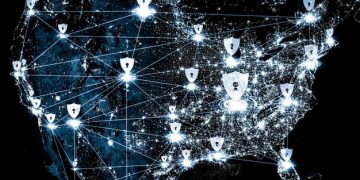AI Cybersecurity Threats to US Businesses in 2025: What’s Coming?

In 2025, US businesses will face new cybersecurity threats driven by AI, including sophisticated phishing attacks, AI-powered malware, deepfake scams targeting executives, and automated vulnerability exploitation, necessitating advanced AI-driven defenses.
The cybersecurity landscape is constantly evolving, and with the rapid advancement of artificial intelligence (AI), US businesses face a new wave of potential threats. What New Cybersecurity Threats Will AI Pose to US Businesses in 2025? Understanding these emerging risks is crucial for proactive defense and ensuring business resilience.
Understanding the Evolving Threat Landscape
The digital realm of cybersecurity is in perpetual motion, evolving at a pace commensurate with technological advancements. The exponential rise of artificial intelligence (AI) has ushered in an era of unprecedented security challenges for businesses, particularly those operating within the United States. Looking ahead to 2025, the threat landscape is poised to become increasingly complex and sophisticated, demanding a proactive and adaptive approach to cybersecurity.
In this context, it’s essential to explore how specific AI-driven threats are likely to manifest and impact businesses. The sophistication and automation that AI brings to both attack and defense strategies necessitate a deep understanding of the potential risks.
The Rise of AI-Powered Attacks
The capabilities of AI can be exploited to create attacks that are more sophisticated and difficult to detect than conventional methods.
- Automated Phishing Campaigns: AI can automate the creation and dissemination of phishing emails, tailoring them to individual recipients with unprecedented accuracy.
- AI-Driven Malware: AI can be used to develop malware that is capable of learning and adapting to defenses, making it more difficult to detect and neutralize.
- Deepfake Scams: Manipulated media can be leveraged to impersonate executives and facilitate fraudulent financial transactions.
These AI-driven attacks have the potential to cause significant financial and reputational damage to US businesses. The sophistication of these attacks requires businesses to implement advanced security measures that go beyond traditional approaches.

Advanced Phishing Attacks Using AI
Phishing, a long-standing cybersecurity threat, is set to reach new levels of sophistication with the integration of artificial intelligence. In 2025, US businesses can expect to encounter phishing attacks that are not only more convincing but also automated and highly personalized.
AI’s ability to analyze vast amounts of data and adapt to individual behaviors makes it a potent tool for creating phishing campaigns that are exceptionally difficult to detect.
AI-Powered Personalization
AI’s aptitude for data analysis and personalized targeting ensures phishing emails are crafted with unprecedented accuracy, making them significantly more challenging to detect.
Real-Time Adaptation Based on User Interaction
AI algorithms can dynamically adjust phishing strategies based on real-time user interaction, optimizing for maximum deception and success.
- Bypassing Traditional Security Filters: AI can intelligently craft phishing emails to evade traditional security filters and spam detectors by analyzing and mimicking legitimate communication patterns.
- Mimicking Trusted Sources: By impersonating trusted sources, AI can generate phishing emails that closely resemble messages from banks, vendors, or internal company communications.
- Multi-Channel Phishing: AI can coordinate phishing attacks across multiple channels, including email, SMS, and social media.
Defending against these advanced phishing attacks requires a multi-layered approach that combines employee training, advanced email security solutions, and continuous monitoring.
AI-Enhanced Malware and Ransomware
Malware and ransomware attacks have long been a major concern for businesses, and in 2025, artificial intelligence is poised to make these threats even more formidable. AI can enhance malware and ransomware in several ways, making them more difficult to detect and neutralize.
The integration of AI into malware and ransomware attacks introduces new challenges for cybersecurity professionals. Traditional security measures may not be sufficient to defend against these advanced threats.
Adaptive Malware
Traditional malware operates using predefined rules and signatures. AI, however, enables malware to dynamically adapt its behavior in response to the environment in which it operates.
AI can learn from previous attacks and adapt its behavior to evade detection. This can be especially effective in bypassing signature-based detection methods, which are a standard component of many security solutions.
Autonomous Propagation
Some AI-enhanced malware can propagate autonomously, spreading from system to system without human intervention. This allows it to spread rapidly across a network, infecting a large number of devices in a short period of time.
- Zero-Day Exploits: AI can scan systems for previously unknown vulnerabilities and develop exploits to take advantage of them.
- Evasive Techniques: AI can use advanced obfuscation techniques to hide its presence and activity, making it difficult to detect.
- Automated Encryption: AI can automate the encryption process, making it more efficient and harder to interrupt.
To defend against AI-enhanced malware and ransomware, businesses must implement advanced threat detection and response solutions. These should leverage machine learning to identify and neutralize AI-driven attacks in real time.
Deepfake Technology for Social Engineering
Deepfake technology, which involves creating convincing but fake videos and audio recordings, is becoming increasingly sophisticated and accessible. In 2025, US businesses face the risk of deepfake attacks being used for social engineering.
The use of deepfakes in social engineering can be particularly damaging, as it exploits the human tendency to trust visual and auditory information. This can lead to significant financial losses and reputational damage.

Executive Impersonation
Deepfakes can be used to impersonate executives, enabling attackers to make fraudulent requests or spread disinformation.
Attackers can use AI to create deepfake videos or audio recordings of CEOs or other high-ranking executives. These deepfakes can then be used to authorize fraudulent wire transfers, endorse bogus business deals, or spread false information.
Damaging Reputational Attacks
Deepfakes can be used to create videos that damage the reputation of a business or its executives.
- Fraudulent Transactions: Deepfakes can be used to trick employees into initiating fraudulent financial transactions by impersonating trusted authorities.
- Reputation Manipulation: Competitors could use deepfakes to spread misinformation or defame key personnel, potentially damaging a company’s image.
- Internal Disruption: Deepfakes can cause confusion and distrust within an organization by creating misleading communications that appear to come from internal sources.
To defend against deepfake attacks, businesses should implement a combination of technical and educational measures. This includes using deepfake detection tools, educating employees about the risks of deepfakes, and establishing clear protocols for verifying requests that appear to come from executives.
Automated Vulnerability Exploitation
Vulnerability exploitation is a common method used by attackers to gain access to systems and data. In 2025, AI is expected to automate the process of vulnerability exploitation, making it faster and more efficient, posing a significant threat to US businesses.
The automation of vulnerability exploitation increases the speed and scale of attacks, making it more difficult for businesses to defend themselves. Traditional patching and vulnerability management strategies may not be sufficient to protect against these automated attacks.
Rapid Scanning and Exploitation
AI can be used to rapidly scan networks for known vulnerabilities and automatically exploit them.
Predictive Vulnerability Analysis
AI can analyze code and network traffic to predict which systems are most likely to be vulnerable to attack.
- Efficient Scanning: AI can scan networks more efficiently, identifying vulnerabilities with greater speed and pinpoint accuracy.
- Automated Exploitation: AI can automate the exploitation of discovered vulnerabilities, reducing the time window for defenders to respond.
- Custom Exploit Development: Advanced AI tools can even generate custom exploits for newly discovered or zero-day vulnerabilities.
To defend against automated vulnerability exploitation, businesses should implement proactive vulnerability management programs. This includes regularly scanning for vulnerabilities, patching systems quickly, and using intrusion detection systems to identify and block exploit attempts.
AI-Driven Cybersecurity Defense Strategies
While AI presents new threats to cybersecurity, it also offers opportunities to enhance defenses. US businesses can leverage AI to improve threat detection, incident response, and overall security posture in 2025.
AI-driven cybersecurity defense strategies can provide a more proactive and adaptive approach to security. These strategies can help businesses stay ahead of evolving threats and improve their overall security posture.
AI-Powered Threat Detection
AI can analyze vast amounts of security data to identify anomalies and potential threats. This can help businesses detect attacks that might otherwise go unnoticed.
Automated Incident Response
AI can automate incident response tasks, such as isolating infected systems and restoring data from backups. This can help businesses respond to attacks more quickly and effectively.
- Behavioral Analysis: AI can analyze user and system behavior to identify anomalies that might indicate a security breach.
- Threat Intelligence: AI can analyze threat intelligence feeds to identify emerging threats and adapt security measures accordingly.
- Adaptive Security: AI can adapt security measures based on the current threat landscape, automatically adjusting firewalls, intrusion detection systems, and other security tools.
To effectively implement AI-driven cybersecurity defense strategies, businesses should invest in training their security personnel and partnering with AI experts. They should also carefully evaluate the performance of AI-based security tools to ensure that they are delivering the intended benefits.
| Key Point | Brief Description |
|---|---|
| 🎣 AI Phishing | Highly personalized and automated phishing emails become more deceptive. |
| 🤖 AI Malware | Malware adapts in real-time to evade detection and cause greater harm. |
| 🎭 Deepfakes | Deepfake videos manipulate executives for fraudulent activities. |
| 🛡️ AI Defense | AI-driven tools improve threat detection and automated incident response. |
FAQ
▼
The main threats include AI-powered phishing, AI-driven malware, deepfake scams, and automated vulnerability exploitation. Each poses unique challenges requiring advanced defenses.
▼
AI leverages data to craft personalized emails, mimicking trusted sources and adapting strategies based on user interaction, making them harder to detect.
▼
AI enables malware to adapt in real-time, autonomously propagate, and exploit zero-day vulnerabilities, bypassing traditional security measures and increasing infection rates.
▼
Deepfakes impersonate executives to authorize fraudulent transactions or damage reputations by creating misleading communications, exploiting trust in visual and auditory information.
▼
Businesses can implement AI-driven threat detection, automated incident response, and proactive vulnerability management programs leveraging machine learning and behavioral analysis.
Conclusion
As we approach 2025, it’s evident that US businesses must prepare for a new era of cybersecurity threats powered by AI. Proactive strategies, continuous learning, and adaptive security measures are essential to protect against these evolving risks and maintain business resilience.





